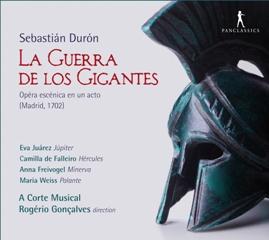Sebastián Durón – La Guerra De Los Gigantes (1982/2013)
Sebastián Durón – La Guerra De Los Gigantes (1982/2013)

1. Xacara 2:33 2. Citaras dulces 6:50 3. Se numen y voz (La Fama) 3:39 4. Aunque mas vuele (El Tiempo) 5:02 5. Quien primero que la fama (La Inmortalidad) 3:10 6. Tiempo eternidad y fama (El Silencio) 3:36 7. Scene 1: Disformes hixos (Palante, Gigantes) 1:20 8. Scene 1: Estender nuestro imperio (Palante) 1:03 9. Scene 1: Alarma, alarma! (Palante, Gigantes) 1:24 10. Scene 2: Aquila ynpaziente (Jupiter) 1:48 11. Scene 2: Y ya que barado el buelo (Jupiter, Minerva) 1:06 12. Scene 2: Esa monstruosa espezie (Minerva, Gigantes) 4:01 13. Scene 2: Ya en mi oido (Jupiter, Minerva) 1:22 14. Scene 2: Buzentoro de plumas (Jupiter, Minerva) 1:16 15. Scene 3: Animoso denuedo (Hercules, Minerva) 2:51 16. Scene 3: Quien eres divina (Hercules, Minerva) 3:04 17. Sacrilego impulso (Hercules, Minerva) 1:31 18. Aora si si (Hercules, Minerva) 3:35 19. Osados esquadrones (Jupiter, Hercules, Palante) 2:51 20. Scene 4: Mas que es esto deidades? (Jupiter, Palante) 2:50 21. Scene 5: Donde, cielo divino (Palante, Minerva) 5:30 22. Scene 5: Jobe, Hercules, Minerva, Dioses (Palante) 3:47 23. Scene 6: Suenen y al dulze achizo (Jupiter) 4:37 24. Scene 6: Como oy no a de ser (Hercules, Minerva, Jupiter) 2:01 25. Scene 6: A de la tierra (Jupiter, Minerva, Hercules, Chorus) 2:05 Eva Juarez (soprano) Camilla De Falleiro (soprano) Anna Freivogel (mezzo-soprano) Maria Weiss (mezzo-soprano) A Corte Musical Rogerio Goncalves - conductor
'La Guerra de los Gigantes' Sebastián Durón is one of the earliest Spanish operas in the history of music: a musical rarity in a stirring presentation by Rogerio Gonçalves, his Ensemble A Corte Musical as well as singers Eva Juárez (Jupiter), Camilla de Falleiro (Hercules), Anna Freivogel (Minerva) and Maria Weiss (Palante). This 'War of the Giants' is about the battle of colossuses who, incited by their leader, Palante, rebel against the gods but are ultimately defeated. In setting this warlike storyline, Durón makes use of a musical language influenced by Spanish folk music and in which the rhythmic complexity is particularly impressive. The music's special timbre is largely due to the use of a natural trumpet, guitars, harp and percussion instruments. Composed in 1702 for the occasion of an aristocratic wedding, Durón gives evidence of his reverence for the new Bourbon King Philip V through his skilled integration of both Italian and French formal elements. The mythological plot of this 'opéra escénica' can be interpreted as an allegory of the incipient Spanish war of succession Durón, who had received highest honours at the court as maestro of the Real Capilla under Charles II, made no secret of his pro-Habsburg attitude. It was probably only thanks to his good connections to the Spanish high nobility that he was able to return to the Madrid court after having lived in French exile beginning in 1706. ---prestomusic.com
Sebastián Durón (1660-1716) was an extremely talented composer, chapel master and organist working in Madrid for the Habsburg court at the time of the War of the Spanish Succession. During those years his loyalties were severely tested and he eventually had to take refuge in France, at Bayonne in the Pays Basque. The war forms the basis of this one-act opera, 'The War of the Giants', whose plot is an allegory of the conflict between Habsburg and Bourbon dynasties. The Habsburgs are represented by Greek gods and the Bourbons by giants, with each of the characters – such as Jupiter, Hercules, Minerva and the giant Palante – representing a contemporary historical figure.
The work is arranged into Introducción and six Escenas, ending in victory for the goodies (gods) and defeat or death for the baddies (giants). All the roles are written for high voices – two sopranos and two mezzos; all four singers here, Eva Juárez, Camilla de Falleiro, Anna Freivogel and Maria Weiss, are excellent. The instrumental ensemble, the Swiss-based A Corte Musical, here consist of twelve instruments including a lively part for clarino trumpet. The instrumental balance and textures are beautifully judged and the playing is in excellent style and full of energy, all directed with terrific verve by Rogério Gonçalves.
The arias ('tonadas') are full of catchy tunes and compelling rhythms, enhanced in places by the expertly-handled clarino trumpet of Martin Mühringer. Some of the music is martial in nature, to match the plot and characters, but in other places it is tender and affecting. Especially lovely are some of the duet singing - between Jupiter and Minerva in Scene 2, for example - and the death lament in Scene 5 of the giant Palante. The latter, in time-honoured operatic style, takes a good few minutes of fine singing to die - to such an extent that Minerva, who speared him ages ago, has to tell him to get on with it.
Booklet notes, in four languages including English, are extremely interesting and useful, further enhanced by some enjoyable photos of the stage production which accompanied this recording. The text of the Spanish libretto is supplied; there is no English translation, but the synopsis is so detailed and readable that listeners are most unlikely to feel deprived. Even if you were to pay little attention to the plot, Sebastián Durón has a remarkable gift for melody and the singing and playing throughout this recording are absolutely lovely. Altogether this is a fascinating, stimulating and thoroughly enjoyable disc. ---Stephen Midgley, amazon.com
download (mp3 @320 kbs):
yandex mediafire ulozto gett bayfiles








